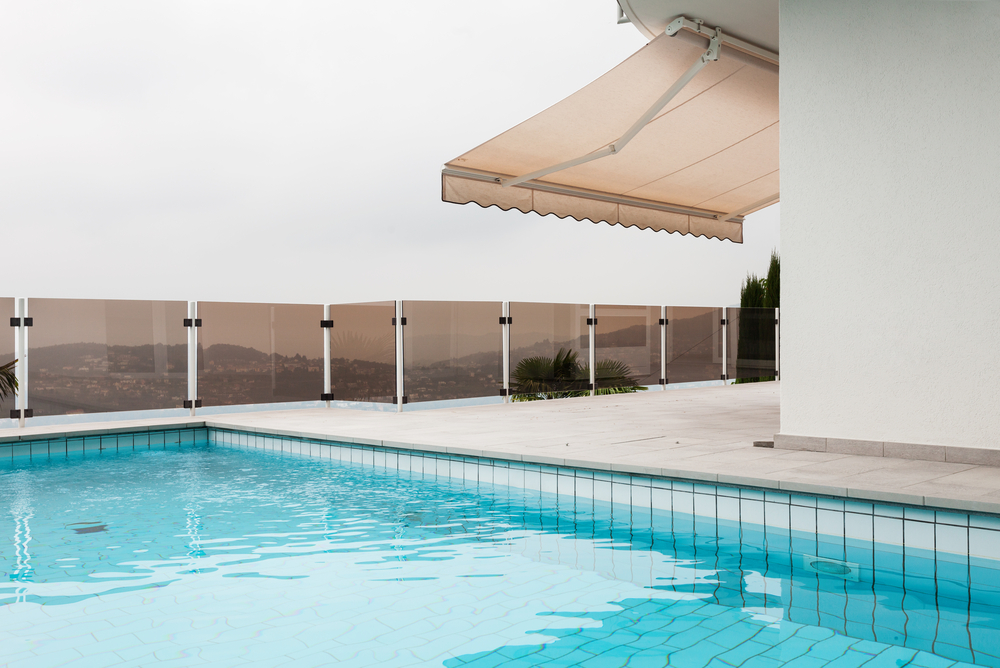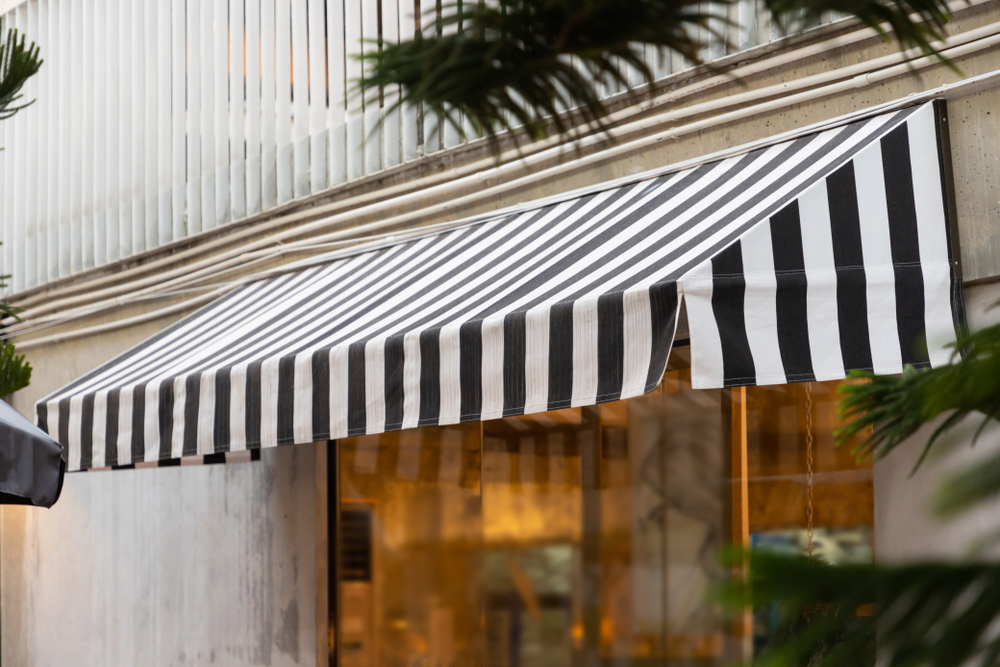Are you fair dinkum feeling the heat in your outdoor space, just like we did a while back? No worries mate, we’ve put our heads together and spent some elbow grease researching practical solutions.
Our guide will take you step by step through how to whip up DIY awnings at home, offering necessary relief from the blinding Aussie sun. Ready for a ripper transformation? Let’s crack on!
Key Takeaways
- Wear eye protection goggles during the awning installation process to keep your eyes safe from flying debris.
- Make sure you have the necessary equipment and tools, including a tape measure, drill with appropriate drill bits, and sockets.
- Locate wall studs before installing your awning to ensure a secure installation. Use a stud finder or tap along the wall to find solid areas for attaching brackets.
- Measure the width of the area where you want to install the awning accurately using a tape measure.
- Cut and secure the frame of your DIY awning by measuring and cutting PVC pipes according to the desired dimensions. Attach mounting brackets to wall studs and insert PVC pipes into them securely.
- Hang your awning carefully by positioning it in place, attaching the frame securely using the provided mounting brackets, and ensuring stability before proceeding.
- Securely attach the covering material by aligning it properly with the frame, using screws or clips for tight fitment, and distributing tension evenly across the surface.
- Use a strong ladder for safety during installation. Make sure it is in good condition and follow ladder safety guidelines when climbing up/down.
- Follow instructions carefully throughout every step of installation for success. Rushing or skipping steps can result in an improperly installed awning that may not provide adequate protection or durability.
- Having an extra person available as assistance can make installing easier/smoother. They can hold/ guide you while securing/handling measurements or offer advice if any issues arise.
- Consider hiring a professional installer for more difficult installations if you lack the necessary tools/experience. They have the knowledge/expertise needed for complex installations. Doing this saves time/effort while ensuring correct first-time installation
Safety Considerations
When it comes to installing your DIY awnings, safety should be a top priority. We recommend wearing eye protection and using the proper equipment and tools to ensure a safe installation process.
Eye protection
Goggles are essential gear during the awning installation process. They safeguard your eyes from dust particles and fragments that could be flying around as you drill holes or cut materials.
It’s crucial to buy a pair of good quality safety goggles, preferably ones that offer 360-degree coverage for optimum protection. A little investment in eye safety can save you from potential harm while carrying out your do-it-yourself project, keeping you focused on getting the job done right.

Proper equipment/tools
To install your DIY awning, it is crucial to have the proper equipment and tools on hand. Here are the essentials you’ll need:
1. Tape measure: Accurate measurements are key when installing an awning, so make sure you have a reliable tape measure to get the right dimensions.
2. Drill with appropriate drill bits: You’ll need a drill to secure mounting brackets and attach the frame of your awning. Make sure you have the correct drill bits for your specific project.
What You’ll Need
To successfully install your DIY awnings, you’ll need a tape measure, drill with appropriate drill bits, and sockets.
Tape measure
We need a tape measure to accurately measure the width of the area where we will be installing our awning. This ensures that the awning fits properly and provides effective coverage.
Using a tape measure allows us to locate wall studs and determine the layout for securing the frame. It is important to ensure the tape measure is accurate so that we can have precise measurements for cutting and installing our DIY awning.
Drill with appropriate drill bits
To install your DIY awning, you’ll need a drill with appropriate drill bits. The drill will be used to create the necessary holes in your wall for mounting brackets and securing the awning frame.
Make sure to choose the right size of drill bit that matches the screws or anchors you are using. This will ensure a secure installation and prevent any damage to your walls. Using the correct tools is essential for a successful DIY project like this one, so be sure to have a drill with appropriate drill bits on hand before getting started.
Sockets
To install your DIY awning, you’ll need sockets. Sockets are essential tools for securing the frame and fastening the awning to your home. They help ensure a sturdy and secure installation.
Make sure you have the right size sockets for the job, as different bolts may require different socket sizes. Having a socket set with various sizes will give you flexibility when it comes to installing your awning.
Remember, using the correct tools is crucial for a successful DIY project.
In addition to sockets, other necessary equipment includes a tape measure, drill with appropriate drill bits, and eye protection goggles. These tools will help ensure precise measurements and safe installation.

Measuring for Your Awning
To measure for your awning, start by locating the wall studs using a stud finder. Then, use a tape measure to accurately measure the width of the area where you want to install the awning.
Make sure to account for any obstructions or fixtures that may affect the installation.
Locating wall studs
To ensure a secure installation, it is important to locate the wall studs before installing your awning. Wall studs are vertical beams within the wall that provide structural support.
You can use a stud finder or tap along the wall to find areas where the sound is more solid and less hollow. Once you’ve located a stud, mark its position with a pencil. Repeat this process along the desired width of your awning, making sure to space out the marks evenly.
By attaching your awning to these sturdy supports, you’ll have peace of mind knowing it’s securely mounted.
Measuring width
To measure the width of your awning, start by locating the wall studs where you plan to install it. Once you’ve found the studs, use a tape measure to determine the distance between them.
This measurement will give you an accurate width for your awning installation. Make sure your tape measure is accurately calibrated and take multiple measurements to ensure accuracy.
Remember that precision is important in this step to ensure a proper fit for your awning frame.
Installing Your Awning
Now it’s time to tackle the installation process for your awning. Start by cutting and securing the frame, making sure it is properly aligned with the measurements you took earlier.
Hang the awning carefully, ensuring that all mounting brackets are securely attached to the wall studs or fascia board. Lastly, secure the covering material in place, making sure it is tight and wrinkle-free for optimal weather protection.
Cutting and securing the frame
To cut and secure the frame for your DIY awning, start by measuring and cutting the PVC pipes according to the desired dimensions. Use a saw or pipe cutter for this task. Next, attach the mounting brackets to the wall studs using appropriate screws or bolts.
Make sure to position them at regular intervals along the length of the frame. Once the brackets are in place, insert the PVC pipes into them and secure them with screws or clamps.
Ensure that everything is level and tightly fastened for a sturdy frame that can support your awning.
Hanging the awning
To hang the awning, begin by positioning it in place and ensuring that it is level. Use the provided mounting brackets to attach the frame securely to your house’s exterior wall. Make sure to use appropriate screws or bolts that are recommended for outdoor use.
Once the frame is attached, double-check its stability before proceeding. Finally, carefully secure the covering material onto the frame using any included straps or fasteners. This step will ensure that your awning stays in place even during windy weather conditions.
Securing the covering material
To complete the installation of your DIY awning, you need to securely attach the covering material. This step ensures that your awning is not only functional but also visually appealing.
First, make sure the covering material is properly aligned with the frame. Use appropriate screws or clips to secure it in place, ensuring a tight fit. Take care to evenly distribute the tension across the entire surface to prevent sagging or bulging.
Lastly, inspect and adjust as needed to ensure a smooth and professional finish. By securing the covering material correctly, you can enjoy your new awning and its protection against the elements for years to come.
Tips for DIY Awnings Installation
When installing your awnings, it’s important to follow these tips for a successful project. Don’t miss out on our expert advice!
Use a strong ladder
To ensure your safety during the installation process, it is crucial to use a strong ladder. This will provide stability and support while you work at heights. Make sure the ladder is in good condition, with no broken or loose parts.
Choose a ladder that can reach the desired height without overextending yourself. Remember to always follow proper ladder safety guidelines and use caution when climbing up and down.
By using a strong and reliable ladder, you can confidently tackle your DIY awning installation project.
Follow instructions carefully
We cannot emphasise enough the importance of following instructions carefully when installing your DIY awning. Every step in the process plays a crucial role in ensuring a successful and safe installation.
Make sure to read through the guide thoroughly before starting, paying close attention to measurements, drilling locations, and securing methods. Rushing or skipping steps can result in an improperly installed awning that may not provide the desired protection or last as long as it should.
Take your time, double-check everything, and follow each instruction precisely for a professional-looking finish that will enhance your home’s exterior while providing much-needed shade and shelter.
Have an extra person for assistance
Installing an awning can be a challenging task, and it’s always helpful to have an extra pair of hands. Having someone else there to assist you can make the process much smoother and safer.
They can help hold the awning in place while you secure it, guide you during measurements, or even offer advice if any issues arise. Whether it’s a friend, family member, or neighbour, having that additional person on hand will ensure that your DIY awning installation goes smoothly and efficiently.
So don’t hesitate to ask for some assistance when tackling this home improvement project!
Consider hiring a professional for difficult installations
When it comes to difficult installations, it’s worth considering hiring a professional. Installing awnings can be challenging, especially for homeowners who may not have the necessary tools or experience.
A professional installer will have the knowledge and expertise to handle complex installations with ease. They can ensure that your awning is securely mounted and properly aligned, minimising any potential damage or safety risks.
By opting for a professional installation, you can save time and effort while ensuring that your awning is installed correctly the first time.
Learn the DIY Awning Installation
In conclusion, this DIY Awnings Installation Guide provides homeowners with the necessary tools and step-by-step instructions to successfully install their awnings. By following these guidelines, you can create a shaded outdoor area that offers protection from the weather.
Remember to prioritise safety and consider asking for assistance if needed. With this guide, you’ll be able to enjoy your newly installed awning in no time!

